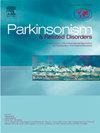Investigating the association between choroid plexus volume and the pathogenesis of Parkinson's disease
IF 3.4
3区 医学
Q2 CLINICAL NEUROLOGY
引用次数: 0
Abstract
Background and objective
Parkinson's disease (PD) involves motor and cognitive impairments, with recent evidence suggesting that changes in choroid plexus volume (CPV) may contribute to disease progression by affecting protein accumulation in the brain. This study aims to assess the relationship between CPV and PD symptoms, and explore its potential as a biomarker for tracking disease progression.
Methods
Data from 236 newly diagnosed, untreated PD patients and 47 healthy controls were retrospectively obtained from a large (n = 412) longitudinal study of patients. CPV was measured using T1-weighted Magnetic Resonance Imaging and normalized by intracranial volume. Clinical assessments included Movement Disorder Society Unified PD Rating Scale (MDS-UPDRS), Montreal Cognitive Assessment (MoCA), Letter-Number Sequencing (LNS), and Symbol Digit Modalities Test (SDMT). Cross-sectional, longitudinal analyses, and mediation analysis, were performed.
Results
PD patients had significantly lower CPV than controls (p < 0.001). Reduced CPV was associated with worse motor (MDS-UPDRS, p = 0.017) and cognitive scores (MoCA, p = 0.005). Over three years, patients with lower CPV experienced faster declines in working memory and processing speed (LNS, p = 0.018; SDMT, p = 0.014). Mediation analysis indicated that Tau protein levels partly mediated the relationship between CPV and baseline cognitive function.
Conclusion
CPV is strongly associated with motor and cognitive decline in PD and may serve as a biomarker for disease progression. Its reduction appears to be linked to pathological protein accumulation, accelerating cognitive deterioration. Incorporating CPV measurements in clinical practice could improve PD diagnosis and management.
脉络膜丛体积与帕金森病发病机制的关系研究
背景和目的帕金森病(PD)涉及运动和认知障碍,最近的证据表明脉络膜丛体积(CPV)的变化可能通过影响大脑中蛋白质的积累而促进疾病的进展。本研究旨在评估CPV与PD症状之间的关系,并探索其作为跟踪疾病进展的生物标志物的潜力。方法从一项大型(n = 412)患者纵向研究中回顾性获得236例新诊断、未经治疗的PD患者和47例健康对照者的数据。CPV采用t1加权磁共振成像测量,颅内容积归一化。临床评估包括运动障碍学会统一PD评定量表(MDS-UPDRS)、蒙特利尔认知评估(MoCA)、字母数字排序(LNS)和符号数字模式测试(SDMT)。进行了横断面分析、纵向分析和中介分析。结果spd患者CPV明显低于对照组(p < 0.001)。CPV降低与运动(MDS-UPDRS, p = 0.017)和认知评分(MoCA, p = 0.005)恶化相关。三年后,CPV越低的患者工作记忆和处理速度下降越快(LNS, p = 0.018; SDMT, p = 0.014)。中介分析表明Tau蛋白水平部分介导CPV与基线认知功能的关系。结论cpv与PD患者的运动和认知能力下降密切相关,可作为疾病进展的生物标志物。它的减少似乎与病理性蛋白质积累有关,加速了认知能力的退化。在临床实践中结合CPV测量可以提高PD的诊断和治疗。
本文章由计算机程序翻译,如有差异,请以英文原文为准。
求助全文
约1分钟内获得全文
求助全文
来源期刊

Parkinsonism & related disorders
医学-临床神经学
CiteScore
6.20
自引率
4.90%
发文量
292
审稿时长
39 days
期刊介绍:
Parkinsonism & Related Disorders publishes the results of basic and clinical research contributing to the understanding, diagnosis and treatment of all neurodegenerative syndromes in which Parkinsonism, Essential Tremor or related movement disorders may be a feature. Regular features will include: Review Articles, Point of View articles, Full-length Articles, Short Communications, Case Reports and Letter to the Editor.
 求助内容:
求助内容: 应助结果提醒方式:
应助结果提醒方式:


